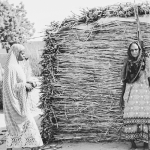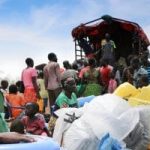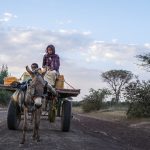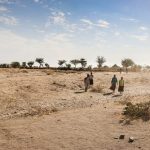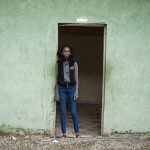
30.000 signs of hope in Gambella
Boom. Boom. Boom. Under a large mango tree, somewhere on the banks of the river that meanders along Gambella, a rhythmic thump can be heard. In the shade on the water’s edge, Angege sits on the ground with about twenty other women, their legs stretched out. With precise swipes, the hard workers concentrate on a pile of soil in front of them, slowly softening the ground. Now and then they wipe the sweat from their faces in silence.
A timid woman with a kind gaze – every morning, the mother of five, abandoned by her husband, gets up before dawn to send her children out. Once they’re at school, Angege walks to work, a kilometre from her modest cabin. She is delighted with her job, she says shyly. Without her monthly salary from ZOA, she would have never been able to send her children to school. And their education is important because her children are Angege’s only hope for a better life.
She works with dozens of vulnerable women and several men at the ZOA nursery, where thousands of trees are grown. In a while, during the sowing season, all kinds of seeds will grow into green shoots, which will bloom a few miles away at their final destination.
“We hope to bring some peace.”
Hope for the refugees and Ethiopia: Planting trees
ZOA’s nursery is located about 45 minutes by car from Gambella, the capital of the region of the same name, not far from the South Sudanese border. Unlike the cool Ethiopian highlands, Gambella is a tropical region, which our Foreign Affairs ministry advises to stay away from. It is a region regularly startled by violence and has been home to some 450,000 refugees since the war in South Sudan. This enormous influx of refugees is hard for the local population due to the lack of jobs and opportunities. In addition, both Ethiopians and South Sudanese need firewood for cooking, which means clearing the refugee camps and the landscape around Gambella.
“Gambella’s landscape is becoming increasingly monotonous,” says ZOA employee Mesay Berecha. “Twenty years ago, this area had very diverse flora and fauna. The massive felling of trees leads to erosion and problems such as drought and floods.” More than enough reason to act: ZOA already started a unique project in 2015 where we planted thousands of trees. Not only on a 500-hectare piece of land selected by the government, but later also in refugee camps, where the sun is hot, and shade is scarce. The trees are planted by both refugees and local Ethiopians, who can earn an income for their families this way.
The nursery is staffed by Ethiopians – around sixty people are trained in the maintenance of trees and forestry. “A unique project.”, says Mesay. “Although the depletion of natural resources is a major problem, ZOA is one of the few organizations that focuses on the environment in Gambella. I think it is great that we do not only focus on refugees, for which it is easier to receive subsidies, but also do not forget about the vulnerable people in Ethiopia. This way, we hope to bring people together and thus also bring a bit of peace.”
Someone who could use some peace is Simon, a South Sudanese who lives with his wife and child in a small hut in one of the refugee camps. While one of our jeeps drives through the camp, Simon points out ZOA logos that can be seen everywhere. “Most people have lived here for about five years now, since the start of the war. We are not allowed to work, which makes it difficult for us to earn any money.” Simon was happy to be given the opportunity by ZOA to earn an income after all. “By planting trees, ZOA makes our camp greener, we are grateful for that.” In the backseat of the jeep, Mesay gives Simon a friendly look. “If we can both restore the landscape of Gambella and reduce tensions in this region, we are happy. Then this project is a success in our opinion.”


